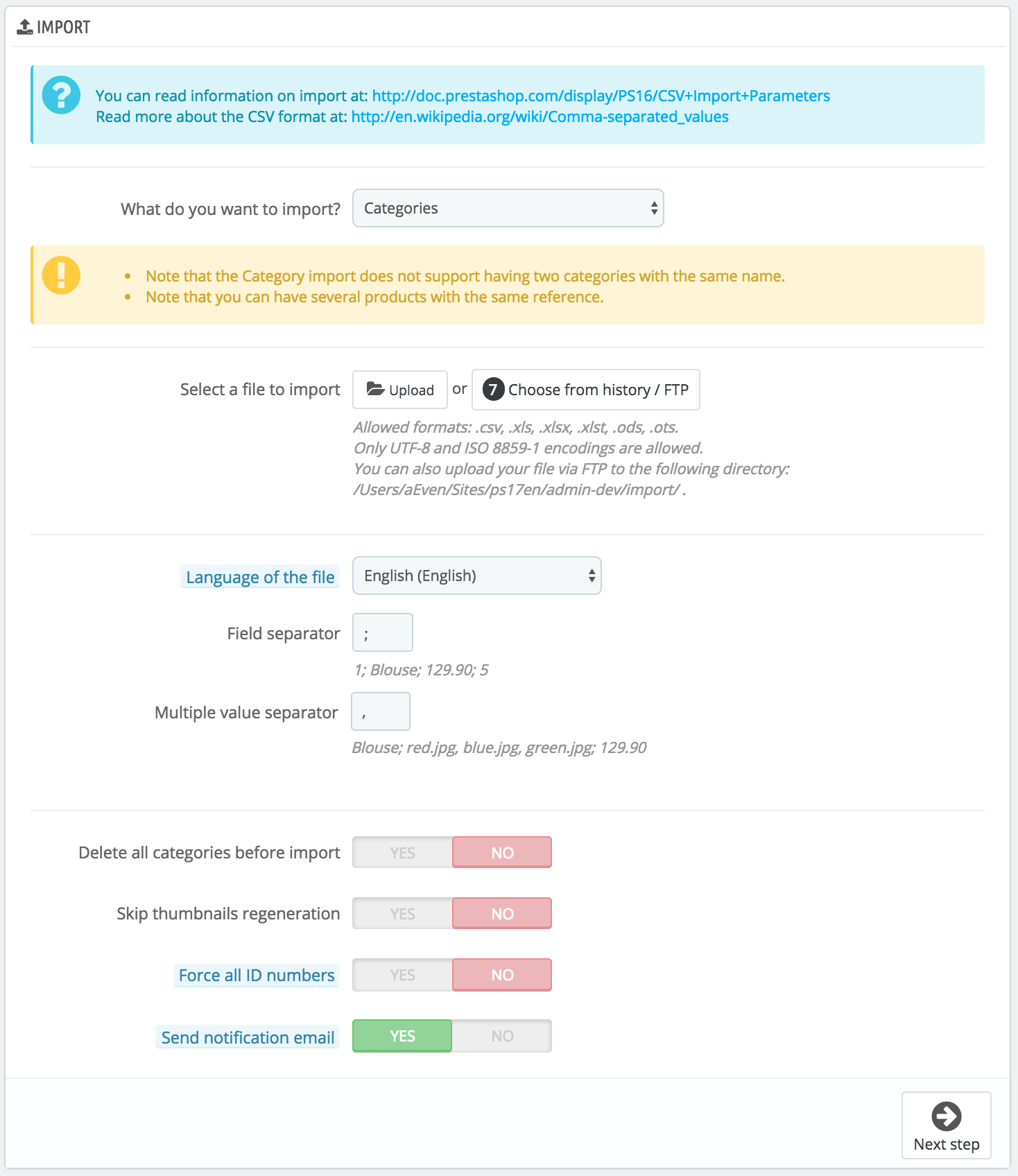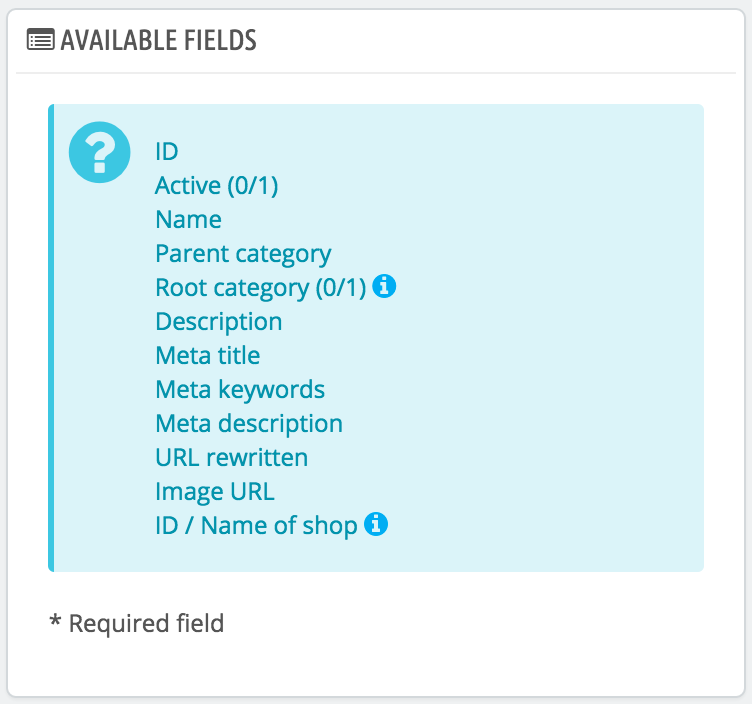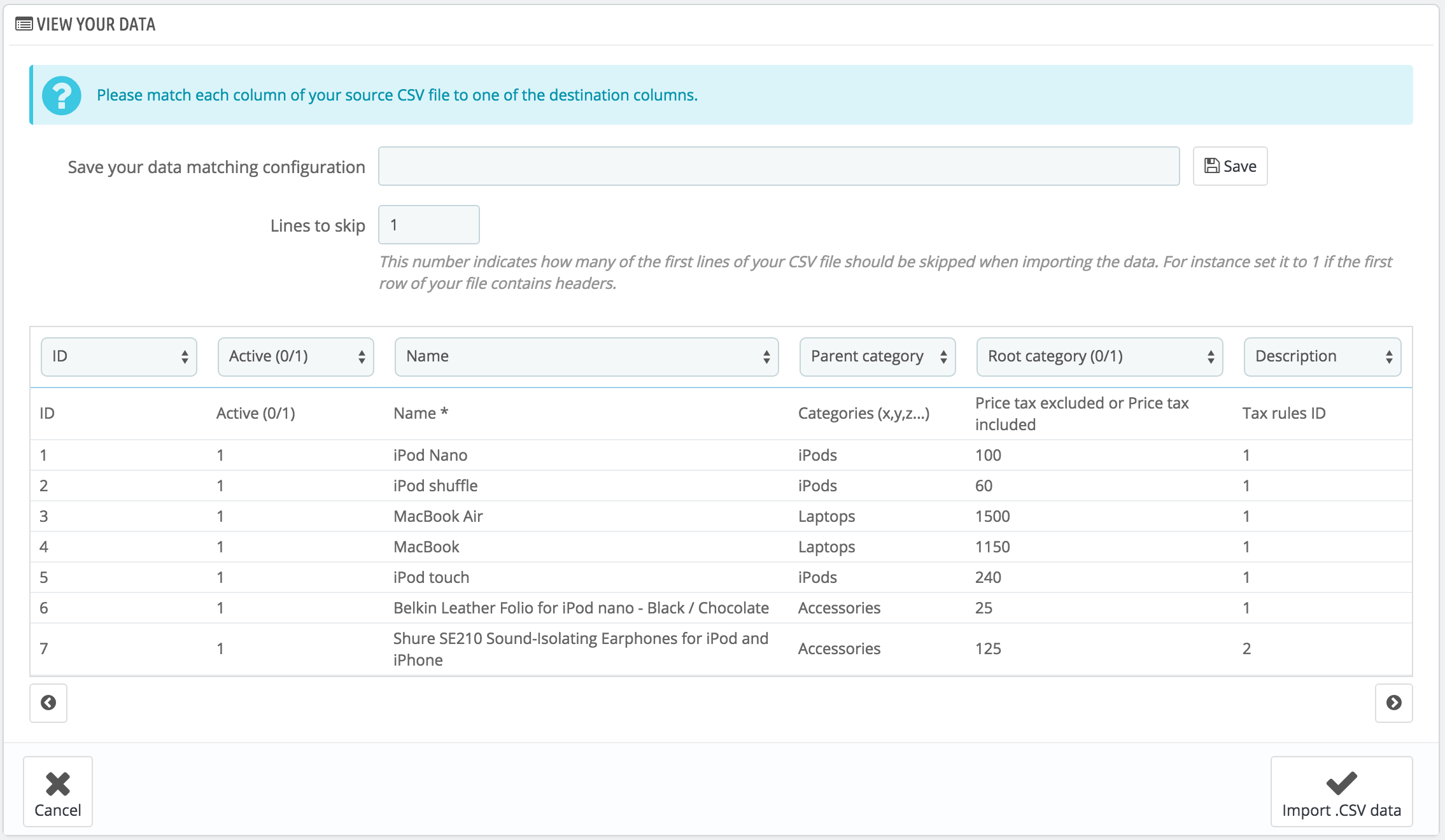
La página de importación le permite introducir fácilmente una gran cantidad de productos a su catálogo, o importar datos que exportó y convirtió desde otra herramienta de comercio electrónico.
Históricamente, las importaciones en PrestaShop se realizaban utilizando archivos .CSV. Desde la versión 1.7, se admiten otros formatos de archivo, como .xls, .xlsx, .xlst, .ods y .ots.
CSV es un acrónimo de "valores separados por comas". Es un archivo de texto plano que se utiliza cuanto hay una necesidad de importar, exportar o simplemente almacenar datos en un formato no propietario. Puede obtener mayor información sobre el formato CSV en el siguiente enlace de la Wikipedia: http://es.wikipedia.org/wiki/CSV. |

El proceso de importación requiere de la preparación del archivo, y cumplimentar el formulario que presenta la configuración principal:
Select a file to import. You can import more than one file at a time, but make sure that they all contain the same type of data. You can either upload files from your computer, or choose files already available on your FTP/ in your history.
You can download sample files for each type of data from the "Download sample CSV files" section on the right. This helps you compare these sample files with your own files, so that you can make sure that the files you are about to import are indeed ready to be imported to PrestaShop. These files are actually stored in the |
Language of the file. Data can only be imported for a single language at a time. If your data exists in more than one language, you should split it into as many files.
When changing the entity you wish to import, the section on the right, titled "Available fields", changes to present the expected data fields. Although the importing tool helps you by taking care of matching your file's fields with PrestaShop's, you should strive to make your data more import-friendly by following the naming scheme and order of the presented fields. If not, the import will be more tedious, but not impossible.
Some fields have a little information popup available (represented by an "i" logo), which you can display by hovering the mouse cursor over it. They mostly pertain to PrestaShop's multistore or advanced stock management features. Make sure to read them all in order to better build/edit your data files.

Imported data file must be in text-file, using a CSV-based format and the accompanying .csv file extension. We recommend using a semicolon ";" as a field separator. If you textual data (product description and such) contains semicolons, you should either remove them, or choose another separator in the "Field separator" option.
You can create a CSV file using any text editor (we recommend Notepad++: http://notepad-plus-plus.org/), but we do advise you to use a spreadsheet program, then save your work in the CSV format. Using a spreadsheet program enables you to have an easier and more visual grasp of your data, in comparison to the plain text file. You can use the commercial Microsoft Excel (http://office.microsoft.com/en-us/excel/ or the free OpenOffice.org http://www.openoffice.org/ Calc.
Here is a sample import file, with a list of products:
"Enabled";"Name";"Categories";"Price";"Tax rule ID";"Buying price";"On sale";"Reference";"Weight";"Quantity";"Short desc.";"Long desc";"Images URL" 1;"Test";"1,2,3";130;1;75;0;"PROD-TEST";"0.500";10;"'Tis a short desc.";"This is a long description.";"http://www.myprestashop/images/product1.gif" 0;"Test 02";"1,5";110;1;65;0;"PROD-TEST2";"0.500";10;"'Tis also a short desc.";"This is a long description too.";"http://www.myprestashop/images/product2.gif" 1;"Test 03";"4,5";150;1;85;0;"PROD-TEST3";"0.500";10;"'Tis a short desc. again";"This is also a long description.";"http://www.myprestashop/images/product3.gif" |
Note that this is only a regular sample files built for this demonstration; it is purposefully not optimized for PrestaShop importation. If you need a sample file you can learn from, use the ones you can download from the "Download sample CSV files".
The first row should be a descriptive name for the data column (you will be able to skip it during the import process). There must be the same number of columns on each row.
You should remember that:
2013-06-21 15:07:27.Once you have all your data in CSV format, you can upload them to your store's database using the form on this page.
You have two ways to register files to import:
/admin-dev/import folder of your PrestaShop installation. Reload the import page: the "Choose from history / FTP" button should now indicate a number. Click the button to display the list of available files (including the ones you previously uploaded using the browser), then click the "Use" button for the file you wish to import.Once your files are all listed in the "Select a file to import" section, you can proceed with the rest of the form:
;", "multiple value separators" with a comma ","). But obviously, if your CSV file is built differently, you should change these values accordingly.All import files are uploaded directly in the admin folder's |
When clicking the "Next step" button, the page reloads with the data mapping tool. This interface helps you map your file's data columns with the ones required by PrestaShop.

Presented in this table are the rows from your file, placed under arbitrary columns matched to PrestaShop's database needs. It is up to you to make sure that all the columns from your CSV file are matched with the correct column header, using each header's drop-down selector, so as to import your content correctly.
For instance, with our sample file:
The screen cannot contain more than 6 columns, so click the ">" and "<" buttons to see the other columns, and make sure to match them all correctly.
In our example, we used the first row for column names. Since we do not want these imported, enter "1" in the "Rows to skip" text-field.
Once you are done matching your columns, click the "Import" button (bottom right-hand corner of the screen), and PrestaShop will start the importing process. A pop-up window will open to show you the progress of the import.
When the process is done, it should indicate "100% validated" and "100% imported". When closing this pop-up, you are sent to the main screen. If an error occurred during the import, you will see a notice of all the encountered problems. In this second case, you should review your file and make sure to correct everything.
The mapping process can be a tedious task if you cannot customize your file columns order according to that used by the PrestaShop importer, and even more so if you have to do that repeatedly or frequently. That is why PrestaShop includes a small tool to save the current mapping order that you have set up using all the headers drop-down selectors.

The tool is a simple field at the top of the matching tool. You can do the three basic actions (only one if there is no mapping configuration saved yet):